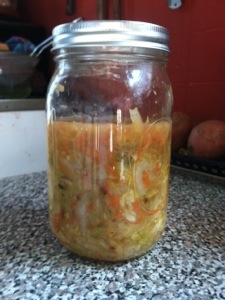Summer is really here. July 4th is this week, and people are lighting up their grills all around. Today I stopped by Brooklyn Kitchen. I was looking for one thing, and fell upon another: CHEESE DOGS. My grandma Baba used to make a microwave cheese dog for me when I was a kid. She’d slice open an Oscar Meyer wiener, filling it with American Cheese, and nuke the puppy for a minute. In contrast, the dogs I got today are a little more sophisticated, pre-stuffed, a lot more natural, and I prepared mine on a cast iron skillet. At this point in my life, eating a hotdog is really a thinly disguised excuse for me to eat a grand amount of sauerkraut. As if I need an excuse….
Some time ago, I wrote up a master recipe for sauerkraut. My recent creation is a little more embellished, although the basics remain the same.
Sauerkraut with Carrots and Burdock
Finely slice 1 head of cabbage
Scrub clean 1 carrot and 1-2 burdock roots. You don’t need to peel them.
Grate the carrot and the roots. I use a box grater on one of the courser settings.
Mix all the ingredients together with 1T sea salt. Let them sit for an hour or more, so that the salt starts to help the veggies release their juices. After an hour, massage and pound your kraut, and then stuff it tightly into a jar. A quart sized mason jar should be large enough. Your kraut needs to be macerated enough that the juices rise above the salad. Let it sit, covered for 3 days to a month. The kraut is ready when you think it tastes right. Mine sat for about 5 days so far, and it’s good enough to use, but I’m still going to let it stay out a little longer to continue it’s fermentation. During the fermentation time, you should check the sauerkraut every day or two for done-ness. This is also helpful because as gasses build up from the fermenting process, the container needs to be “burped.”
On Mold
Kraut can last a long time in the refrigerator once it is done fermenting. I made a large batch last year that took me about 6 months to finish, and it was none the worse for wear. The one problem you might come into contact with is mold. I made a batch of my basic kraut, only using red cabbage, back in March, and somehow it hasn’t had much luck. I’m not sure why, except that maybe it’s always been a little low on fluid. The good news is that mold only grows where your veggies are exposed to air. The stuff under the brine is just fine. I’ve kept eating this one, carefully skimming off the mold when it grows. White mold, according to other fermenters I’ve talked to, is pretty innocuous. If you have blue mold, that’s a case to throw it out. The stuff below looks blue in the picture, but that’s just because my camera is picking up the hues of the purple cabbage underneath.





